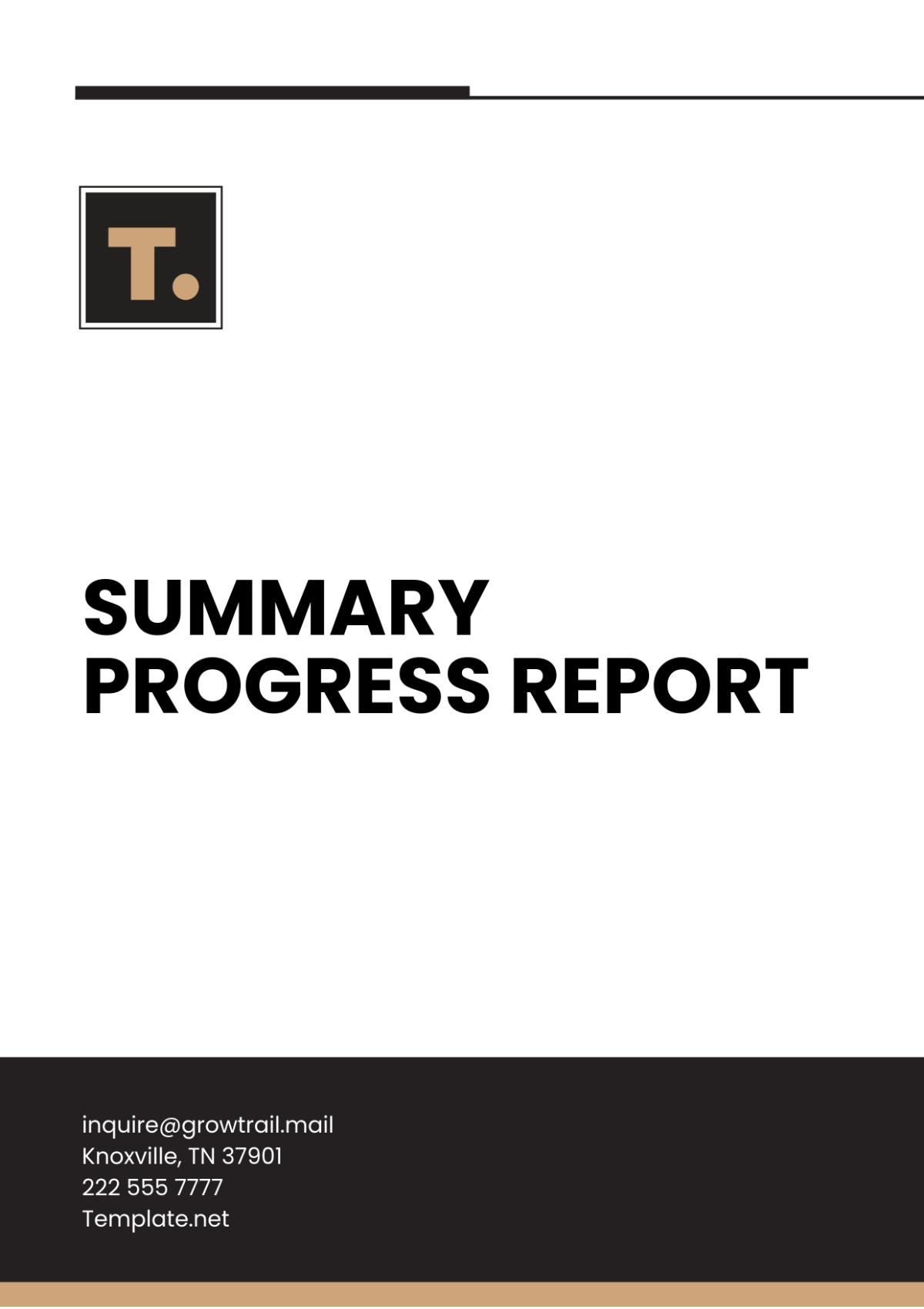Free Online Learning Summary Report Template
Online Learning Summary Report
I. Introduction
In the digital age, online learning has emerged as a transformative force in the education sector, revolutionizing how knowledge is accessed and delivered. It has broken down geographical and socioeconomic barriers, providing learners with unparalleled access to a wide range of educational resources and courses. This accessibility enables students from diverse backgrounds to customize their learning experiences, progressing at their own pace while engaging with content tailored to their individual needs. [Your Company Name] recognizes the significance of online learning in shaping the future of education and is committed to fostering innovation in this rapidly evolving space.
As technology advances, online learning has expanded beyond traditional classroom settings, offering learners the flexibility to acquire knowledge from anywhere in the world. This report by [Your Company Name] offers a comprehensive overview of the current state of online learning, examining its development over time, highlighting the latest trends, addressing the challenges faced by institutions and learners, and exploring the future prospects for this dynamic field. With an emphasis on meeting US educational standards, the report provides valuable insights for stakeholders in the online education landscape.
II. History and Evolution
A. Origins of Online Learning
The concept of online learning dates back to the late 20th century, with the rise of digital technology and the internet fundamentally transforming education. In the early 1990s, as the internet became more widely available, educational institutions began exploring ways to leverage this technology to reach a broader and more diverse audience. The first online courses were basic, often text-based, and delivered via email or static web pages. Despite their simplicity, these courses marked the beginning of a shift in how education could be delivered, offering a new level of flexibility for students unable to attend traditional, in-person classes due to location, work commitments, or other constraints.
As the demand for distance learning grew, universities and colleges began establishing dedicated online learning programs. By the late 1990s and early 2000s, the introduction of learning management systems (LMS) allowed educators to create more structured and interactive course materials. This era marked a significant milestone in the democratization of education, where knowledge became more accessible to people regardless of their geographical location. [Your Company Name] is part of this ongoing evolution, delivering learning solutions that build upon these early innovations.
B. Technological Advancements
Technological advancements have been a driving force in the evolution of online learning, continuously shaping and redefining the educational landscape. In the early stages, courses were limited to basic tools like email, static PDFs, and forums, but the rapid development of multimedia, cloud computing, and high-speed internet dramatically expanded what was possible. By the 2000s, Learning Management Systems (LMS) had evolved to support more dynamic, interactive learning environments, incorporating video lectures, real-time discussions, and collaborative projects.
With the rise of Web 2.0 and mobile technologies, online learning became even more accessible, empowering learners to access content on multiple devices, including smartphones and tablets. Today, cutting-edge innovations such as artificial intelligence (AI), augmented reality (AR), and virtual reality (VR) are enhancing engagement by creating immersive learning experiences. These technologies enable personalized learning paths, real-time feedback, and interactive simulations that mirror real-world scenarios. [Your Company Name] utilizes these advancements to create more engaging, flexible, and learner-centered educational experiences, ensuring that learners have the tools they need to succeed in an increasingly digital world.
III. Current Trends
A. Increasing Adoption
Online learning has seen a surge in adoption due to its flexibility and cost-effectiveness. According to recent studies, a significant percentage of students worldwide are enrolling in online courses.
B. Popular Platforms
Various platforms dominate the online learning landscape, each offering unique features:
Platform | Key Features |
|---|---|
Coursera | Partnered with universities, wide range of courses |
edX | Nonprofit, emphasis on research-based course development |
Udemy | User-generated courses, diverse topics |
C. Gamification and Interactive Content
The integration of gamification elements and interactive content such as quizzes and simulations is rapidly gaining popularity in online learning. These features help in sustaining student interest and improving retention rates.
IV. Challenges
A. Quality Assurance
Ensuring consistent quality across online courses remains a significant challenge in the field of online learning. While many established platforms maintain rigorous standards—accrediting courses and implementing strict content oversight—others may provide inconsistent experiences. This can result in uneven educational outcomes, where students may complete courses without meeting the learning objectives. Additionally, the vast proliferation of online learning providers makes it difficult for students to discern which platforms offer legitimate, high-quality education. [Your Company Name] is committed to maintaining high standards by adhering to industry best practices, regularly updating course content, and ensuring instructors are qualified professionals with expertise in their fields.
Moreover, quality assurance in online learning involves ensuring courses meet regulatory and accreditation standards set by US education authorities. This includes adhering to the guidelines set by organizations like the U.S. Department of Education, the Council for Higher Education Accreditation (CHEA), and ensuring compliance with state-level regulations. By consistently monitoring and improving course delivery, [Your Company Name] aims to uphold the highest standards, ensuring that learners receive valuable, reliable education that aligns with national benchmarks.
B. Accessibility and Inclusivity
Despite the growth of online learning, achieving full accessibility and inclusivity remains a persistent challenge. Not all students have equal access to the technology required for online education, such as high-speed internet, up-to-date computers, or reliable devices. This digital divide disproportionately affects low-income students and those in rural or underserved areas, limiting their opportunities for education. Furthermore, students with disabilities often face additional hurdles. While accessibility tools like screen readers, captions, and adaptive technologies have made progress, many online platforms still lack full accessibility compliance, as outlined by the Americans with Disabilities Act (ADA) and Section 508 of the Rehabilitation Act.
Inclusivity also involves designing courses that accommodate diverse learning styles and cultural backgrounds. [Your Company Name] is dedicated to creating an equitable learning environment by developing content that meets the needs of all learners, ensuring that its platform adheres to both accessibility guidelines and inclusive instructional design. By fostering an inclusive learning experience, the company aims to minimize barriers and expand educational access to all students, regardless of their socioeconomic status, physical abilities, or geographic location.
C. Student Engagement
One of the most significant challenges in online learning is maintaining student engagement, especially in the absence of face-to-face interaction. The lack of direct communication with instructors and peers can lead to feelings of isolation, making it difficult for students to stay motivated. This isolation may affect learning outcomes, as students benefit from collaboration and real-time feedback, which are more easily facilitated in traditional classroom environments. Online forums, while useful, do not always replicate the immediacy and depth of in-person discussions.
Additionally, online learning often requires a higher level of self-discipline and time management, as the unstructured nature of many online courses can lead to procrastination or disengagement. Without regular check-ins or deadlines, students may struggle to stay on track. [Your Company Name] addresses these challenges by incorporating interactive elements such as live webinars, discussion groups, and peer collaboration tools. Furthermore, the use of AI-driven adaptive learning systems allows [Your Company Name] to personalize learning experiences and provide timely feedback, keeping students motivated and actively engaged throughout their educational journey.
V. Future Prospects
A. Technological Integration
The future of online learning is set to be shaped by the continued integration of cutting-edge technologies, further transforming the educational landscape. Artificial intelligence (AI) will play a crucial role in enhancing personalization by adapting content to each learner’s pace, preferences, and learning style. AI-driven systems can provide real-time feedback, track progress, and even predict challenges a student might face, enabling tailored support. Additionally, machine learning algorithms will improve course recommendations, helping students discover relevant material that aligns with their career goals and interests.
Emerging technologies like augmented reality (AR) and virtual reality (VR) are expected to create more immersive learning environments. These tools will allow students to engage with 3D models, virtual simulations, and interactive content that goes beyond traditional textbooks and videos. In fields such as healthcare, engineering, and the arts, AR and VR will offer hands-on, experiential learning in a digital format. [Your Company Name] is poised to adopt and integrate these technologies, ensuring its platform remains at the forefront of educational innovation and offers learners more engaging and effective experiences.
B. Global Collaborations
As online learning continues to grow, the future will see increased global collaboration between educational institutions, online platforms, and educators. These collaborations will enable the sharing of resources, expertise, and best practices across borders, making high-quality education more accessible to students worldwide. Initiatives such as open educational resources (OER) and massive open online courses (MOOCs) will further democratize education, allowing learners to access top-tier content from renowned universities and organizations regardless of their location.
This globalization of education will also foster a more diverse and interconnected learning experience. Students from different cultures and backgrounds will be able to participate in the same courses, creating rich, cross-cultural exchanges that enhance their learning and global understanding. For institutions, global partnerships will help drive innovation by pooling resources and leveraging diverse perspectives on teaching methodologies. [Your Company Name] is committed to expanding its reach by forging collaborations with international partners, providing its learners with a truly global and enriched educational experience.
VI. Conclusion
Online learning represents a transformative shift in the educational landscape, offering unprecedented opportunities for both learners and educators. Its flexibility, accessibility, and personalized approach have made it a vital tool for students worldwide, breaking down barriers to education and enabling lifelong learning. While challenges such as quality assurance, accessibility, and student engagement persist, continuous advancements in technology and global collaborations are driving the field forward. As innovations like AI, AR, and VR become more integrated into learning platforms, online education will become increasingly immersive and tailored to individual needs. [Your Company Name] remains committed to fostering these advancements, ensuring that education becomes more accessible, engaging, and effective for learners across the globe.





































